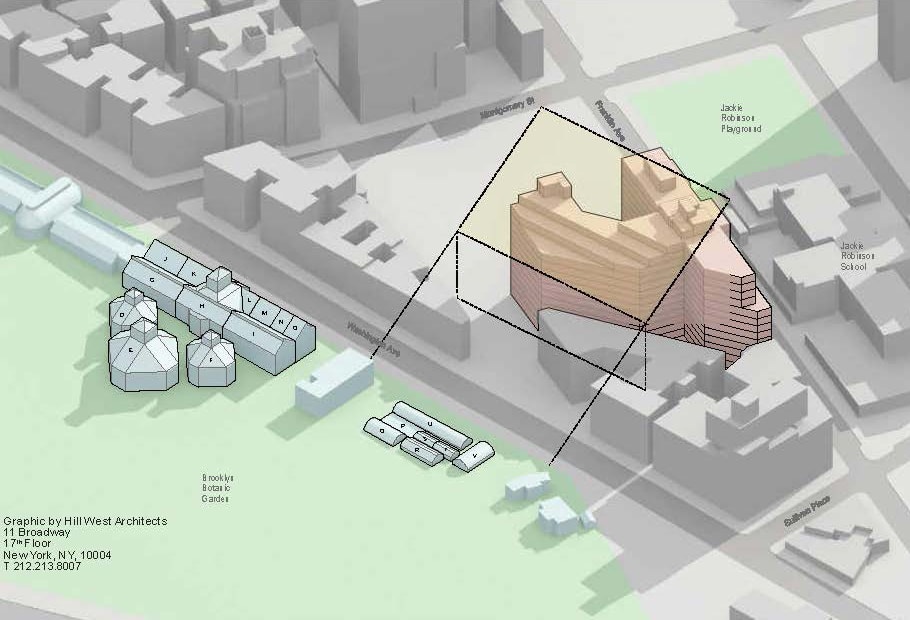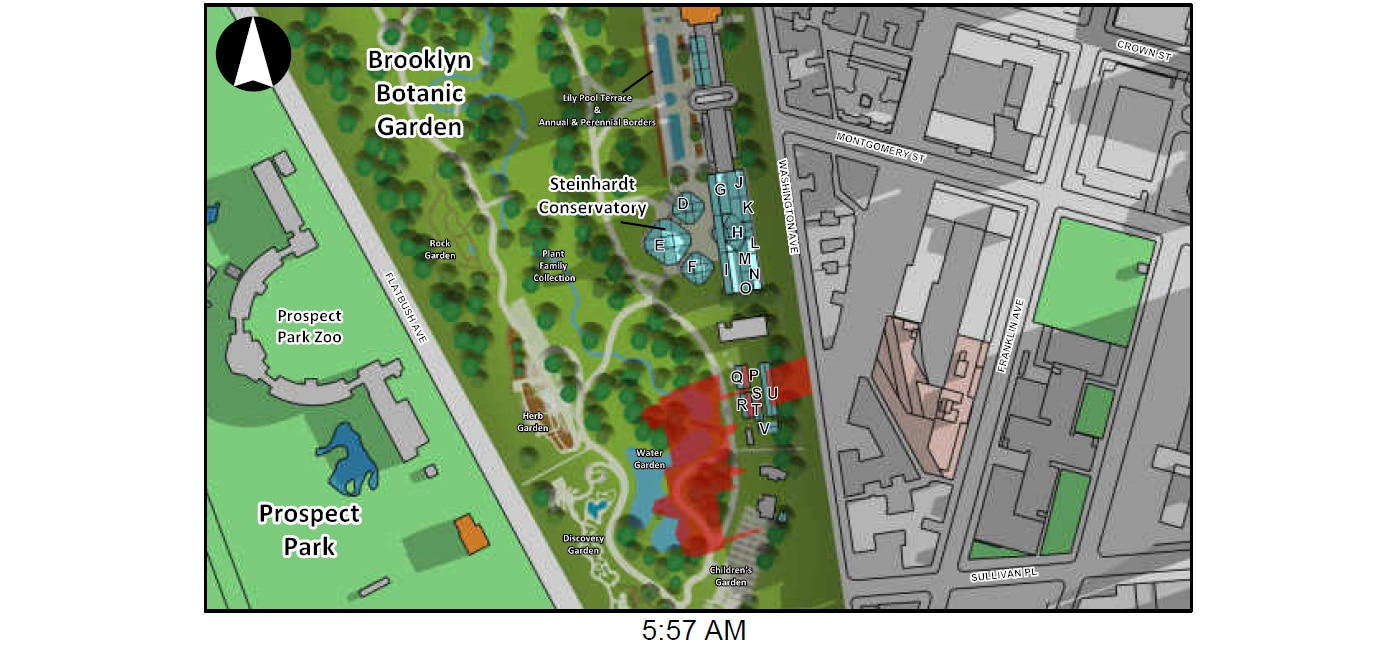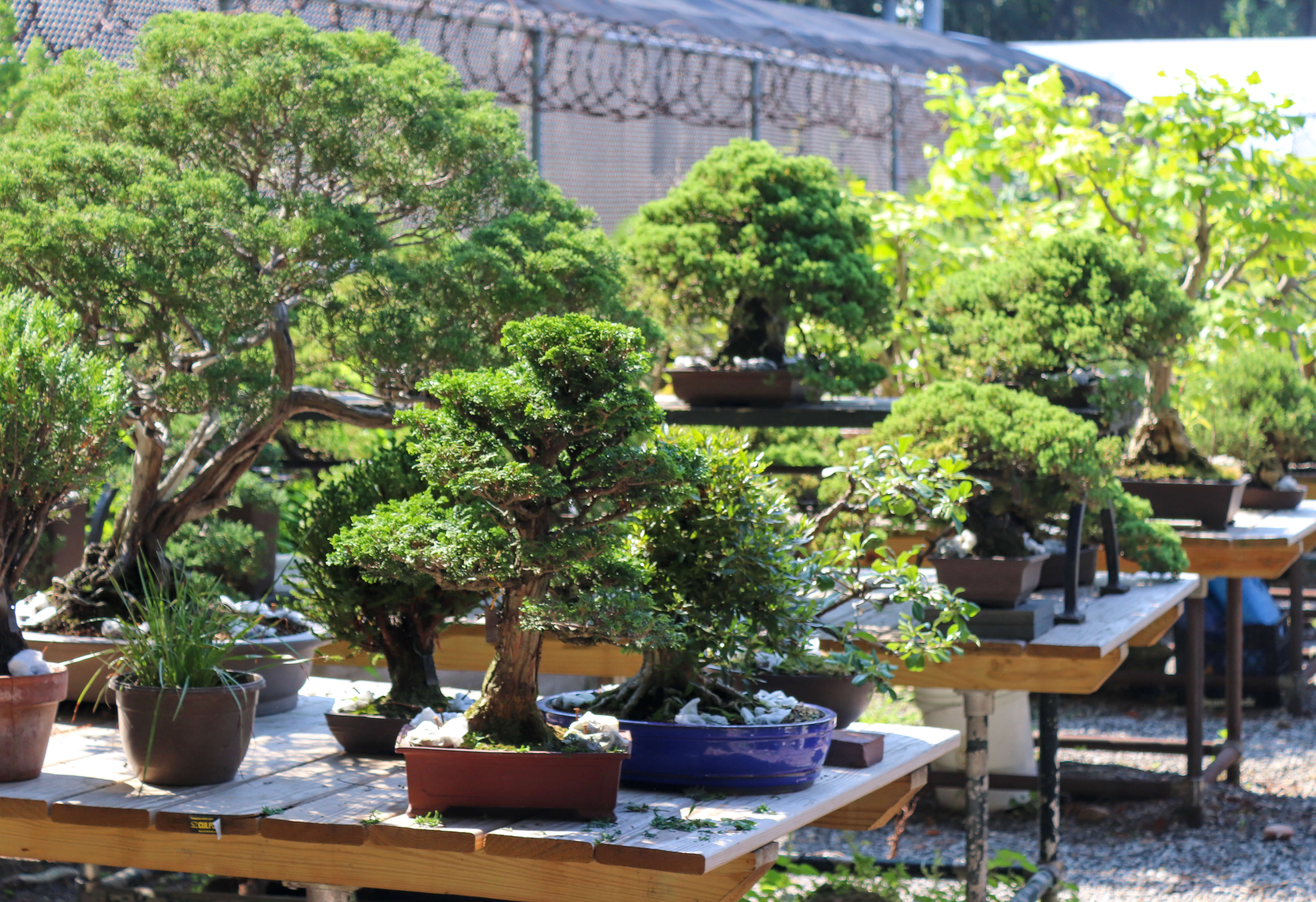Crowd Defends, Again, Botanic Garden From Development Shadows at Heated Hearing
More than 50 people testified on a proposed new 14-story development that would cast shade on the Brooklyn Botanic Garden and a nearby playground.

The conservatory at Brooklyn Botanic Garden in March. Photo by Susan De Vries
Teachers, students, community gardeners, city planners, union workers, Brooklynites barely old enough to stand at a podium, those at the other end of the age spectrum, and many in between, gathered in a room in Downtown Manhattan on Wednesday with the message to protect the Brooklyn Botanic Garden.
Of the more than 50 people who spoke at a packed five and half hour City Planning Commission hearing on a rezoning that would facilitate a new 14-story development on Franklin Avenue in Crown Heights — one that would cast shadows on some of the garden’s most sunlight-sensitive plants and on the Jackie Robinson Playground — only two people were in favor of the rezoning. Both represented union workers who would be employed to build the project, a group that was well represented in the audience and easily spotted in their union shirts.
On the other side of the coin, dozens of speakers testified to the garden’s importance in New York City and globally as a hub of science, education (especially for children), and propagation. Many said that exactly the area where the building would cast shadows is where those activities take place: the education center, nurseries, conservatories, and exotic plant gardens.

For many speakers, and the developers, it was a case of déjà vu. A similar hearing took place just a few years ago on an even bigger proposed development on the same site that would cast shadows on the garden, a 34-story tower that would replace the Spice Factory in the historic former Consumers Park brewery at 960 Franklin Avenue. Also fiercely opposed by the community, that one was rejected by the City Planning Commission and ultimately killed by then Mayor Bill de Blasio. Since then, the Spice Factory has been demolished and the nearly block-long property has been split. This new project has an address of 962-972 Franklin Avenue and once held an ice making and distribution company and the Spice Factory garage.
“Why are we here again? Why? That’s the part I cannot understand,” Flatbush resident Zenobia McNally said. “There’s still thousands of trees in the Brooklyn Botanic Garden, lots of seedlings being planted, lots of animals. What has changed that brings us back here? They all still need the same sunlight they did two years ago, 10 years ago, 100 years ago.”
According to developers Continuum Company, through their lawyer David Rosenberg, a lot has changed — even since they first filed their new proposal with the Department of City Planning earlier this year.



At the hearing, the team, which includes Hill West Architects, presented modified massing for the 14-story, 145-foot-tall, 475-unit rental building that is different from what was included in the environmental review portion of the city’s land-use review process (required for any rezoning). To reduce the shadows and their impact, the new design shrinks the building’s bulkhead and steps down the building’s massing on the garden side.
To date, Continuum Company has not yet released any renderings showing how the building would look when finished. This is perhaps a first in Brooklyn for a major project seeking a rezoning.
If the proposal is approved, the development team has said, the building will be union built, financed, and run — something Rosenberg said likely wouldn’t happen if they build as of right.
Anthony Williamson of Local 79 said the developers had looked at the social, economic, and environmental impact of the project, and created something he said is unique and he hopes will be a model for future development.
“It’s not about just the park or the garden or the flowers, it’s about our future, it’s about our children standing in here, it’s about sending our kids to college, it’s about giving them a good education and background, about putting a roof over their heads, that’s what this is about,” he said.

If the rezoning is rejected and they build as of right, the developers have said, they will construct a seven-story, 168-unit condo building that will be totally market rate. R6A zoning rules, which the site is currently governed by, allow for a 75-foot-tall development (around six to seven stories) with an additional 55-foot-tall bulkhead. With the additional height allowed by City of Yes (if it passes), the building could be nine stories tall, but would need to include 20 percent affordable housing.
Rosenberg said the program offered through City of Yes doesn’t align with the recently extended 421-a program the developers plan to use for the rentals if the rezoning passes.
Overall, Rosenberg said, the modified development will result in a loss of between seven minutes and around an hour and 10 minutes of sunlight in different areas of the south-east section of the garden during peak sunshine months, something he said equates to around a 0.4 percent reduction in sun annually. The modified environmental impact statement technical manual states the reduction of sunlight on the garden would be up to one hour and 32 minutes.
“As the city asks all of us to help address the housing crisis, are we really going to let 0.4 percent stand in the way of 475 apartments, permanently affordable units, and hundreds of union jobs?” Rosenberg asked the commissioners. The total number of rent stabilized, income-capped units would be 119.


While they are dubbed “affordable” by the city, the units would be for households earning 40 to 130 percent of the Area Median Income, or $43,480 to $141,310 for a single person — a number that will undoubtedly increase before the apartments are rented. The affordable units would fall under the city’s Mandatory Inclusionary Housing program, required for any development that benefits from a rezoning.
Rosenberg said the median income for the area is around $80,000, which was met with skepticism from both the crowd and some commissioners. Commissioner Leah Goodridge questioned whether even union workers building the project would be able to afford to live there. She also took issue with the development team stating they would build only market rate condos if the rezoning isn’t approved, saying it feels like a threat to the community.
“This is really antithetical to community engagement. There’s already a lot of skepticism about private developers that come into these communities and don’t listen,” she said. “It’s extremely distasteful, as someone who was born here, grew up here, for a developer to continually say these things and say, ‘well, if I don’t get what I want, there’s going to be punishment’.”

Myla Seabrook, an employee of the Botanic Garden, said she is the community the developers and others speaking on the proposal were talking about. “It is in service to the community that I stand before you now.”
“There are already not enough green spaces and sunlight in the neighborhoods that Black and brown residents live in, and that is largely by design: a combination of gentrification, redlining, and unbridled racism have forced us further away from trees and the sky, and gridlocked us between cold steel buildings we cannot afford to live in,” she said.
“As a Black woman born and raised in New York City, I know well the shadows of developments like this one that is being proposed and what is, for many, the unattainable price of sunlight streaming through a living room window or onto a local playground.”
She said Brooklyn Botanic Garden is a place where three generations of her family have found solace and inspiration, and she rejects the notion that opposing a development that could damage the garden is being unsupportive of affordable housing.
“It is possible to support affordable housing and the natural right we all have to green spaces and sunlight, especially when what we’re calling affordable isn’t affordable or even accessible to large swathes of New York City,” she said. “Taking the sunlight away from kids who are already living in housing projects like at Ebbets Field would be an injustice of the highest order. Sunlight is at a premium for them, and they are not allowed to access it.”

The proposed building would mean a two hour and 40 minute reduction in sunlight at Jackie Robinson Playground at some times of the year, a playground that has a children’s play area, basketball courts, handball courts, a spray shower, and more. And which is already shadowed by the towering Ebbets Field development to the east. Rosenberg said the new development would affect the playground, but so too would an as-of-right building.
In the City Environmental Quality Review, a part of any land use application, the city found the development will create shadows that will have “significant adverse effects” on both the garden and playground.
When CPC commissioner Dan Garodnick asked Rosenberg why the commission should “approve a development that has a significant and unmitigable shadow impact on the Brooklyn Botanic Garden,” Roseberg said he outright rejects that is the situation.
Rosenberg said the report is categorically wrong because it doesn’t include trees that create shade on the areas in question. He also argued BBG and the city had shown no proof that incremental shadows would have adverse impacts on the plants for the periods of time proposed.

BBG VP of Horticulture Rowan Blake challenged that, saying many of the trees included in the developers’ own light study no longer exist, that the study measured light on the roofs of the garden’s buildings and not on its plants, and said the city’s evaluation excludes the first and last 90 minutes of sunlight in a day — not measuring from dawn until sunset.
“With all of the methodological shortfalls, it concludes a fantastical figure of less than 1 percent impact on the garden. This is not a real-world measurement. Our conclusion is that no matter what is proposed in an R8 envelope, it would still have significant, detrimental, unmitigated impact on Brooklyn Botanic Garden,” Blake said.
And, he said, measuring the sunlight on the roofs of the buildings in the gardens rather than the plants is “like having a thermostat for heating and cooling your house and putting it up on the roof. It’s totally irrelevant.”
In terms of mitigating for development, Blake said BBG had already raised its conservatory by one story in preparation for future R6A development in the area, and said they could find a way to manage the 30 minute shade that would create. R8A, however, would be a catastrophe for the garden given many of the equatorial plants in the area are already going off reduced hours vs. what they would get in their natural habitats (especially in winter).

At the start of his testimony, BBG President Adrian Benepe questioned the development team’s assertions on how much light exotic plants need.
“I just want to note, having sat for an hour and a half with the developers suddenly becoming experts in plant science and the health needs of plants, so much so that the Parks Department and Brooklyn Botanic Garden don’t know what they’re talking about when it comes to plant health, is interesting,” he said. “And I would suggest that developers saying they’re advocates for the health needs of plants is like the chairman of Dow Chemical Company saying they know what’s good for rivers and streams and the creatures that live within them.”
Benepe urged the commission to reject the proposal, which he said “pits a modest number of affordable units in a mostly market rate building against a 115-year-old public asset that’s completely dependent on sunlight to serve its community. Once they take away the sunlight, it’s never coming back.”
He added that the garden hadn’t spoken out against other developments in the past and is doing so on this one because the loss of sunlight would cause existential harm to BBG for generations to come.
Commissioner Juan Camilo Osorio noted that Brooklyn Borough President Antonio Reynoso proposed in his recent report rejecting the rezoning a new special zoning district for sunlight sensitive areas called the Solar Access Special District. Benepe said it is a “visionary” idea and he said he supports such additional protection for the garden, especially the area in question with its delicate species and habitats.

The plants in the conservatory, some of the sensitive species at the center of the debate, are from all over the world, Benepe said, and are there “to show children in Brooklyn who will never travel to those places” what they are like.
“Most of us can’t, and we’ll never see the interior rainforest, but the Brooklyn schoolchild’s experience of the rainforest starts when they enter our tropical house,” he said.
He added it is also imperative to protect the sunlight at Jackie Robinson Playground, saying “when they steal that sunlight, it’s gone forever, and you put a coat of paint on the basketball court or a new swing set, is not going to mitigate stealing that sunset.”
Speakers shared stories of how they and generations of their families had used the gardens as a place of relaxation, community building, and learning, with a number of older speakers recounting how they went as children and now volunteer as seniors. “It is the crown jewel of Kings County,” one person said.

Another, who said she comes from a family of union workers and is one herself, invited the union workers in the crowd supporting the development to come to the garden. “Even hardworking union families need a place to relax and smell the roses. I invite all my union brothers and sisters to come to the garden. Bring your family, bring your children, bring children with special needs. You will have a wonderful time,” she said.
A representative from South Midwood Pollinators said her role at the hearing “was to express the outrage that the average citizen in Brooklyn has expressed when they hear that they’re trying to build again next to the Brooklyn Botanic Garden.”
She said while gardeners are a “scrappy bunch” what they couldn’t do was remediate sunlight. “It is the gift that enables life on the planet as we all know it.”
She added that the developers comparing shade cast by the building to the shade of trees doesn’t stack up, as “buildings are not deciduous, they are just as shadow-producing in the winter as they are in the summer.”
Another speaker questioned why the developer has taken such a “stalwart stance…that all 14 stories are required for them to contract union labor and include affordable housing.”
“BBG sunlight and critical horticultural operations should not be held hostage by a developer who has no intrinsic motivation to support affordable housing beyond an occasional gesture beyond the requisite. Ultimately, I must ask if BBG’s next 100 years of community engagement and resources can be weighed against a mostly market rate apartment building.”

Amanda White and her young son took to the podium near the end of the marathon session to talk about how the local pair visited Jackie Robinson Playground almost every week. “My family and my neighbors rely on this public space for its nature, its recreation, its warmth and sunshine to rejuvenate our spirits and to restore our bodies. We will not accept our health and our peace of mind being compromised for more luxury condos in our ever gentrifying neighborhood,” she said.
As a kindergarten teacher who frequently takes her students to BBG, White added that the indoor environments of the greenhouses and conservatories “offer a warm respite and allow us to continue our important work of understanding the natural world.”
“My students are so young that they need concrete experiences to learn big concepts, abstract concepts, like habitat, ecosystems, climate, and diversity. We can observe our favorite fruits growing in the tropical collection and explore all kinds of fuzzy, prickly, funny-shaped plants in the desert collection,” she said.
“We can’t travel to the Middle East or the Caribbean, where some of my students’ heritage traces, but we can still experience up close what kind of nature grows there.”
She said the microclimates the collections depend on are extremely sensitive and if they were to lose any sunlight, especially during the winter, “the plants would die, and we would lose this extremely valuable resource.”
CPC will accept written testimony on the proposal until Monday August 19. The commission will then hold a vote on the proposal, which will later be voted on by the city council.
Related Stories
- Proposed Crown Heights Build Would Cast Harmful Shadows on Botanic Garden
- With Light-Blocking Tower Plan Dead, Spice Factory Owners Plan Mid-Rise Building in Crown Heights
- Citing Risk to Botanic Garden, City Planning Commission Will Vote No on Crown Heights Tower
Email tips@brownstoner.com with further comments, questions or tips. Follow Brownstoner on Twitter and Instagram, and like us on Facebook.









What's Your Take? Leave a Comment